This article was co-authored by Mayami Oyanagi. Mayami Oyanagi is a Physical Therapist and the owner of PT STOP Physical Therapy & Wellness, an individualized physical therapy practice in Los Angeles, California. With over 14 years of experience, Mayami specializes in orthopedic injuries, manual therapy, and sports medicine. She holds an MS in Physical Therapy from the University of Hartford. Mayami is also a board certified Orthopedic Clinical Specialist. She treats the root cause of her client’s problems by utilizing biomechanical assessments.
This article has been viewed 276,507 times.
Properly adjusting the height of an office chair will take a load off your back, literally. Sitting awkwardly in a chair can cause you to slouch, crouch forward, and type at an uncomfortable angle. Any of these issues can cause pain or even disability if left uncorrected. Luckily, these problems can often be avoided simply by adjusting your office chair height. Using the chair's controls, you can make it so you don't have to sit awkwardly.
Steps
Raising and Lowering a Chair
-
1Look for hand controls. Most office chairs have levers located just below the seat, attached to the base. There might be several to control features like the seat height and angle. You can adjust the height by pulling up on the proper lever if you're already in the chair.[1]
- For some models, you will turn a knob instead of pulling on a lever.
- If aren't sure which lever controls the height, you can either read the chair's instructions, or just pull the levers until you find the right one.
-
2Raise and lower the seat until it's comfortable. With most chairs, once you've pushed the right lever, the seat will raise and lower freely. Move it until you find the “sweet spot” that's just right for you. Do this gently, slowly moving the chair only inches (or centimeters) at a time. When you're done, move the lever back to the original position.
- Some models may require you to pull up on the lever to raise the seat, but push down on it to lower it.
- Pneumatic models will allow you to “pump” the lever (push it repeatedly up or down to raise or lower the seat).
Advertisement -
3Try adjusting from a standing position if you can't seem to get it right. Stand in front of the chair, and push the proper lever. Raise or lower the seat of the chair until the tip of it is just below your knee cap. You should now be able to sit comfortably in the chair with your feet flat on the floor.[2]
Choosing the Right Chair Height for Your Task
-
1Stay eye level with the monitor when working on a computer. Ideally, the monitor will be just below your your eye level and the keyboard at elbow level. If you can't raise or lower your monitor, you can adjust the seat height to accommodate.[3]
-
2Keep your elbows at desk height when working on its flat surface. This applies when you're doing things like reading a book or something on paper, writing by hand, drawing, etc. Lower or raise your chair height until your elbows and arms can rest comfortably on the desk.[4]
-
3Rest your feet on the floor during extended periods of sitting. If you have to stay put for a while, such as during a meeting, its especially important to be sitting properly. Change your chair height until your feet are flat on the floor so you don't have to sit awkwardly.[5]
Increasing Safety and Comfort
-
1Adjust the height of the armrests, if the chair has them. If you're working at a desk for typing or similar tasks, raise the armrests until they allow you to keep your arms just about level with the desk. If you don't need the arm support, you may be able to remove the armrests, or just lower them so they aren't in your way.[6]
- Lower or remove the armrests if they prevent you from sliding your knees comfortably under your desk.
-
2Change your sitting position every 15-30 minutes. This helps prevent strain and other issues. If you don't need to adjust your chair height because of your work, you can still try shifting your position. For instance, lean forward briefly, then go back to a fully seated position. You could also shift your weight slightly from one side of the chair to the other.[7]
-
3Get a footrest if your chair is too high. It may be that there's just no way to lower your chair so that your feet sit comfortably on the floor while keeping your arms at a comfortable working height. If that's the case, slide an office footrest underneath your desk and prop your feet on that.[8]
- Footrests can be found at office supply stores, and are usually adjustable as well.
Expert Q&A
-
QuestionShould I lean back or sit up straight?
 Mayami OyanagiMayami Oyanagi is a Physical Therapist and the owner of PT STOP Physical Therapy & Wellness, an individualized physical therapy practice in Los Angeles, California. With over 14 years of experience, Mayami specializes in orthopedic injuries, manual therapy, and sports medicine. She holds an MS in Physical Therapy from the University of Hartford. Mayami is also a board certified Orthopedic Clinical Specialist. She treats the root cause of her client’s problems by utilizing biomechanical assessments.
Mayami OyanagiMayami Oyanagi is a Physical Therapist and the owner of PT STOP Physical Therapy & Wellness, an individualized physical therapy practice in Los Angeles, California. With over 14 years of experience, Mayami specializes in orthopedic injuries, manual therapy, and sports medicine. She holds an MS in Physical Therapy from the University of Hartford. Mayami is also a board certified Orthopedic Clinical Specialist. She treats the root cause of her client’s problems by utilizing biomechanical assessments.
Physical Therapist Leaning back every once in a while for a quick stretch is totally fine, but you generally want to be sitting up straight with your spine supported and your feet on the floor.
Leaning back every once in a while for a quick stretch is totally fine, but you generally want to be sitting up straight with your spine supported and your feet on the floor. -
QuestionWhy is the monitor supposed to be at eye level?
 Mayami OyanagiMayami Oyanagi is a Physical Therapist and the owner of PT STOP Physical Therapy & Wellness, an individualized physical therapy practice in Los Angeles, California. With over 14 years of experience, Mayami specializes in orthopedic injuries, manual therapy, and sports medicine. She holds an MS in Physical Therapy from the University of Hartford. Mayami is also a board certified Orthopedic Clinical Specialist. She treats the root cause of her client’s problems by utilizing biomechanical assessments.
Mayami OyanagiMayami Oyanagi is a Physical Therapist and the owner of PT STOP Physical Therapy & Wellness, an individualized physical therapy practice in Los Angeles, California. With over 14 years of experience, Mayami specializes in orthopedic injuries, manual therapy, and sports medicine. She holds an MS in Physical Therapy from the University of Hartford. Mayami is also a board certified Orthopedic Clinical Specialist. She treats the root cause of her client’s problems by utilizing biomechanical assessments.
Physical Therapist Looking straight ahead is the most natural position for your spine and upper back. If you look down or up at all, you're going to eventually get sore.
Looking straight ahead is the most natural position for your spine and upper back. If you look down or up at all, you're going to eventually get sore. -
QuestionHow do I stay in the same position at work without getting sore?
 Mayami OyanagiMayami Oyanagi is a Physical Therapist and the owner of PT STOP Physical Therapy & Wellness, an individualized physical therapy practice in Los Angeles, California. With over 14 years of experience, Mayami specializes in orthopedic injuries, manual therapy, and sports medicine. She holds an MS in Physical Therapy from the University of Hartford. Mayami is also a board certified Orthopedic Clinical Specialist. She treats the root cause of her client’s problems by utilizing biomechanical assessments.
Mayami OyanagiMayami Oyanagi is a Physical Therapist and the owner of PT STOP Physical Therapy & Wellness, an individualized physical therapy practice in Los Angeles, California. With over 14 years of experience, Mayami specializes in orthopedic injuries, manual therapy, and sports medicine. She holds an MS in Physical Therapy from the University of Hartford. Mayami is also a board certified Orthopedic Clinical Specialist. She treats the root cause of her client’s problems by utilizing biomechanical assessments.
Physical Therapist You really can't. It's important that you move around every 30 minutes or so. You really don't want to stay in the same static position for too long. It's just not healthy for you!
You really can't. It's important that you move around every 30 minutes or so. You really don't want to stay in the same static position for too long. It's just not healthy for you!
References
- ↑ https://www.ccohs.ca/oshanswers/ergonomics/office/chair_adjusting.html
- ↑ https://www.ccohs.ca/oshanswers/ergonomics/office/chair_adjusting.html
- ↑ Mayami Oyanagi. Physical Therapist. Expert Interview. 27 January 2021.
- ↑ Mayami Oyanagi. Physical Therapist. Expert Interview. 27 January 2021.
- ↑ Mayami Oyanagi. Physical Therapist. Expert Interview. 27 January 2021.
- ↑ https://www.btod.com/office-chair-adjustment-guide.html
- ↑ Mayami Oyanagi. Physical Therapist. Expert Interview. 27 January 2021.
- ↑ https://www.ors.od.nih.gov/sr/dohs/Documents/Computer%20Workstation%20Ergonomics%20Self%20Assessment%20Checklist.pdf
About This Article
Properly adjusting your office chair is important for having good posture and keeping back pain away. When you adjust the height on your chair, you’ll want your eye level to be straight on with your monitor and your elbows at desk height. Your feet should also be flat on the ground for maximum comfort. If your feet don't touch the floor all the way, you may need to get a footrest, which can be found at office supply stores. If your chair allows you to adjust the armrests, move them so they're level with your desk. For more advice on adjusting your office chair height, read on!
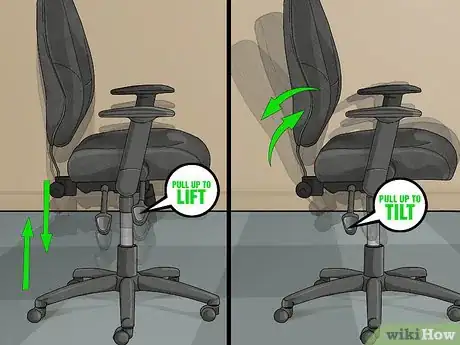
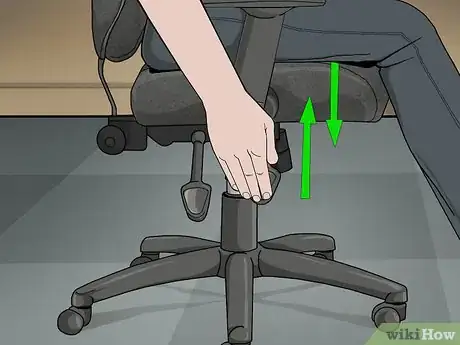
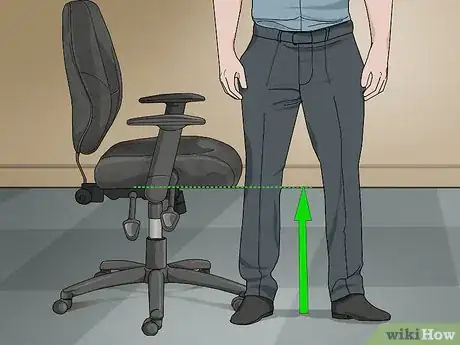


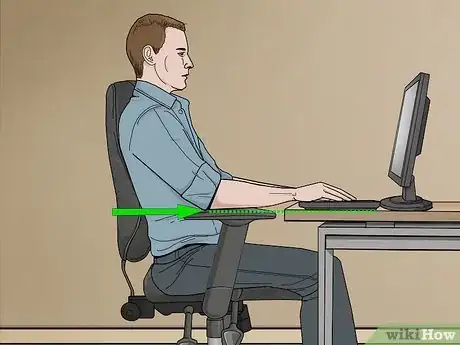
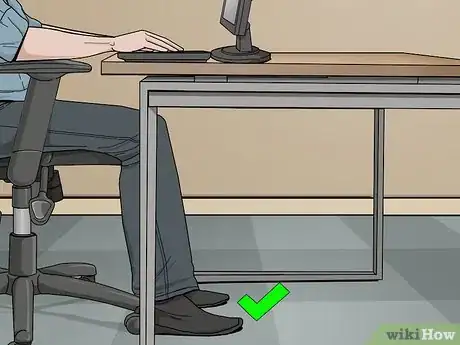
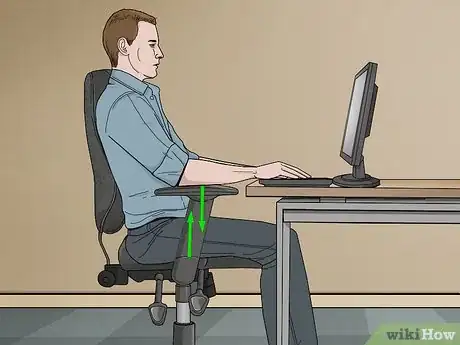
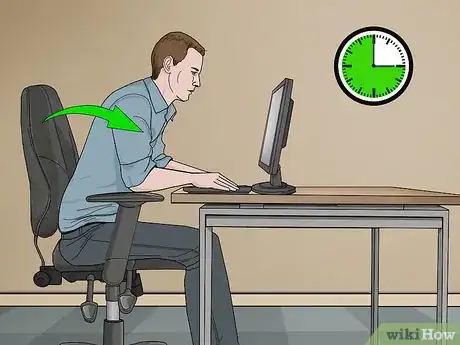























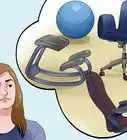





































Medical Disclaimer
The content of this article is not intended to be a substitute for professional medical advice, examination, diagnosis, or treatment. You should always contact your doctor or other qualified healthcare professional before starting, changing, or stopping any kind of health treatment.
Read More...